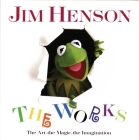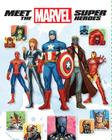There's a new kind of reader in our house.
I've always enjoyed the way that kids have their own reading personalities, their ways of approaching and engaging with books. Eleanor was ready for chapter book read-alouds far earlier than Isabel, and her love of a long, gripping narrative has continued well into her own independent reading years. Isabel has always responded intensely to visuals, and graphic novels have eased her transition from emerging reader to full-on independent reader. Will, it turns out, has a categorizing mind.
 This first became apparent last spring when Eleanor was doing a 2nd grade nonfiction project about Jim Henson. We took a bunch of books out of the library (how much do I love the Brooklyn Public Library?), among them a nice big coffee table book about all of Henson's creative projects ever: Christopher Finch's Jim Henson --The Works: The Art, the Magic, the Imagination.
This first became apparent last spring when Eleanor was doing a 2nd grade nonfiction project about Jim Henson. We took a bunch of books out of the library (how much do I love the Brooklyn Public Library?), among them a nice big coffee table book about all of Henson's creative projects ever: Christopher Finch's Jim Henson --The Works: The Art, the Magic, the Imagination.It's a pretty fabulous book, especially if you're interested in the Muppets at all: accounts of Henson's early life, his first commercial projects, the birth of Sesame Street and the Muppet Show, his later, weirder TV shows and movies. Lots of glossy pictures, including a four-page spread with thumbnails of the guest stars in every Muppet Show episode that ever aired. (Bob Hope! Lesley Ann Warren! Alice Cooper!)
Will became obsessed with this book. He was just over 2 years old, and would sit on the couch turning the pages over and over -- so much so that, after he ripped a couple and we taped them, we returned the book to the library and bought our own used copy. He called it "Gog Book" (for "Frog," a.k.a. Kermit). And as he turned the pages, Will was categorizing: memorizing names and faces, putting things in order in his mind.
He particularly loved the big Muppet monsters: Sweetums, Thog, the purple-bodied twins/triplets The Mutations. One double-page spread contains pictures of the cast of puppeteers, showing who played which characters, and Will would ask us to read all the names: Richard Hunt played Janice, Scooter, Beaker, and Wayne of Wayne and Wanda. "Who played Thog?" The book didn't say. "Look it up on your 'puter, Mommy." I looked it up. Turns out it was Jerry Nelson.
Probably three weeks later, Jeff was reading the Gog Book with Will, and got to that page. "Daddy, Jerry Nelson played Thog." Okay, though it doesn't say that in the book. "No! Jerry Nelson played Thog!" Total nerd recall.
While full-bodied Muppet monsters still hold a place in his heart, Will has lately moved on to a full-fledged superhero obsession. Again, there is so much categorizing going on: the names of superheroes, followed of course by the powers and weapons of each one. What does Batman carry in his utility belt, you ask? Why, among other things, Batarangs, Batcuffs, and Batrope, of course.
As I mentioned in my last post, we've been reading a ton of superhero early reader books, some better than others. Generally speaking, we've found the I Can Read! books featuring the DC superheroes (Batman, Superman, Wonder Woman) to be better written than the World of Reading books about the Marvel superheroes (the Avengers, Spiderman, X-Men). Not loads better, but enough that the language allows you to read aloud with a little dramatic flair.
 Here's Donald Lemke writing Batman: Winter Wasteland:
Here's Donald Lemke writing Batman: Winter Wasteland:When he arrived in Gotham City, he spotted his coldest enemy, Mr. Freeze.
The frozen felon fired icy blasts at nearby buildings.
"Stop right there!" shouted Batman.
The villain turned and smiled.
"Don't you mean freeze?" he asked.
Compare that to Clarissa Wong writing This is Black Widow:
 She was an orphan.
She was an orphan.She lived at the Red Room.
The Red Room was a secret camp.
It was an evil place.
The camp leaders trained her to be a spy.
They taught her to steal.
She knew the Red Room was bad.
Yup, that's the book I read aloud five times yesterday.
 Your latest slam-dunk gift, however, gives me hope for the Marvel universe. A month ago, you gave us Will's current favorite book, Meet the Marvel Superheroes, by Chris "Doc" Wyatt. It's an illustrated character encyclopedia, listing more than 100 Marvel superheroes, from the best-known to some I'd never heard of (Squirrel Girl, anyone?). The lineup is more diverse than I feared it might be -- lots of women, and a decent if not huge number of superheroes of color (Ms. Marvel, a.k.a. Kamala Khan, is the daughter of Pakistani immigrants; Black Panther stars in a new series this year written by Ta-Nehesi Coates). None of the depictions of women are so sexualized as to make me cringe, though it is interesting to note how many of the female superheroes have powers that involve mind control. (Those crazy women -- they can make us do anything they want!)
Your latest slam-dunk gift, however, gives me hope for the Marvel universe. A month ago, you gave us Will's current favorite book, Meet the Marvel Superheroes, by Chris "Doc" Wyatt. It's an illustrated character encyclopedia, listing more than 100 Marvel superheroes, from the best-known to some I'd never heard of (Squirrel Girl, anyone?). The lineup is more diverse than I feared it might be -- lots of women, and a decent if not huge number of superheroes of color (Ms. Marvel, a.k.a. Kamala Khan, is the daughter of Pakistani immigrants; Black Panther stars in a new series this year written by Ta-Nehesi Coates). None of the depictions of women are so sexualized as to make me cringe, though it is interesting to note how many of the female superheroes have powers that involve mind control. (Those crazy women -- they can make us do anything they want!)We read this book all the time. Will has memorized names, relationships, weapons, powers. Each page contains handy thumbnail illustrations of the superheroes related to the one depicted on the page, which helps with the categorization.
I hesitate to be gender reductive here, but it does strike me that I've seen this kind of reading pattern -- learn all the facts about a particular universe, categorize them, repeat them -- more often with boys than with girls. But even as I write that, I think of the power of the superhero narrative: Will takes all of his knowledge and puts it into 24/7 roleplay, dressing up and casting all of us as superheroes around the dinner table, stopping our conversation to announce: "There's a new villain in Gotham City!"
So I'll take a step back from trying to categorize this type of reading, and go get ready to fight crime. You might not know it, but I'm Batwoman.
Love, Annie
